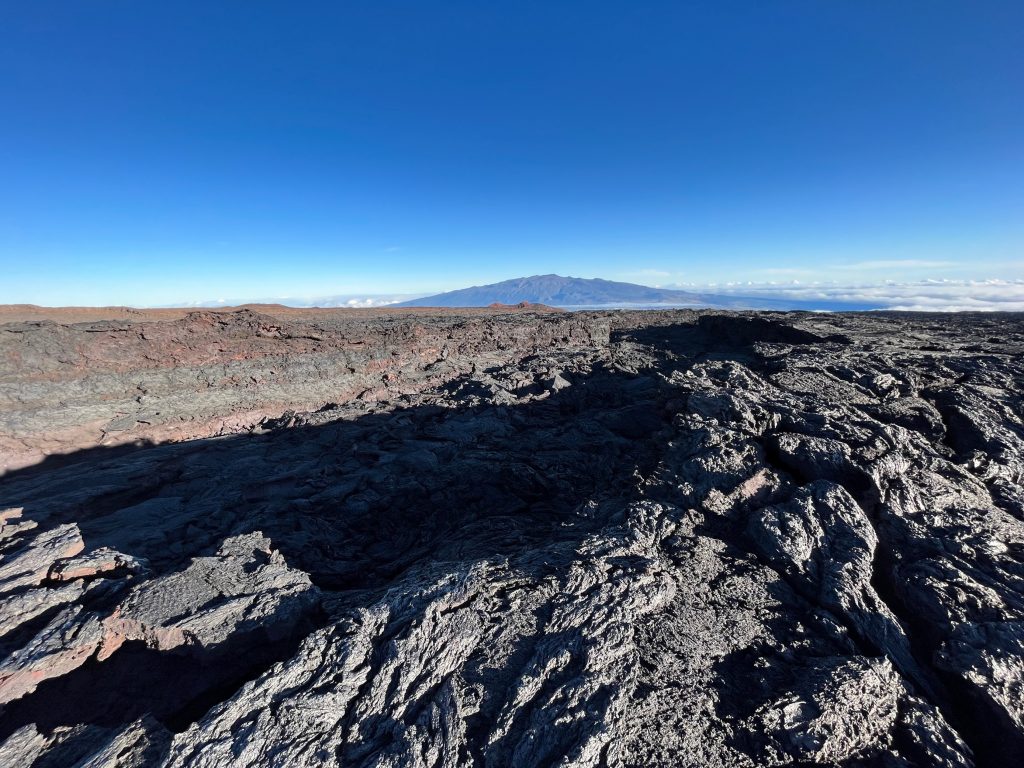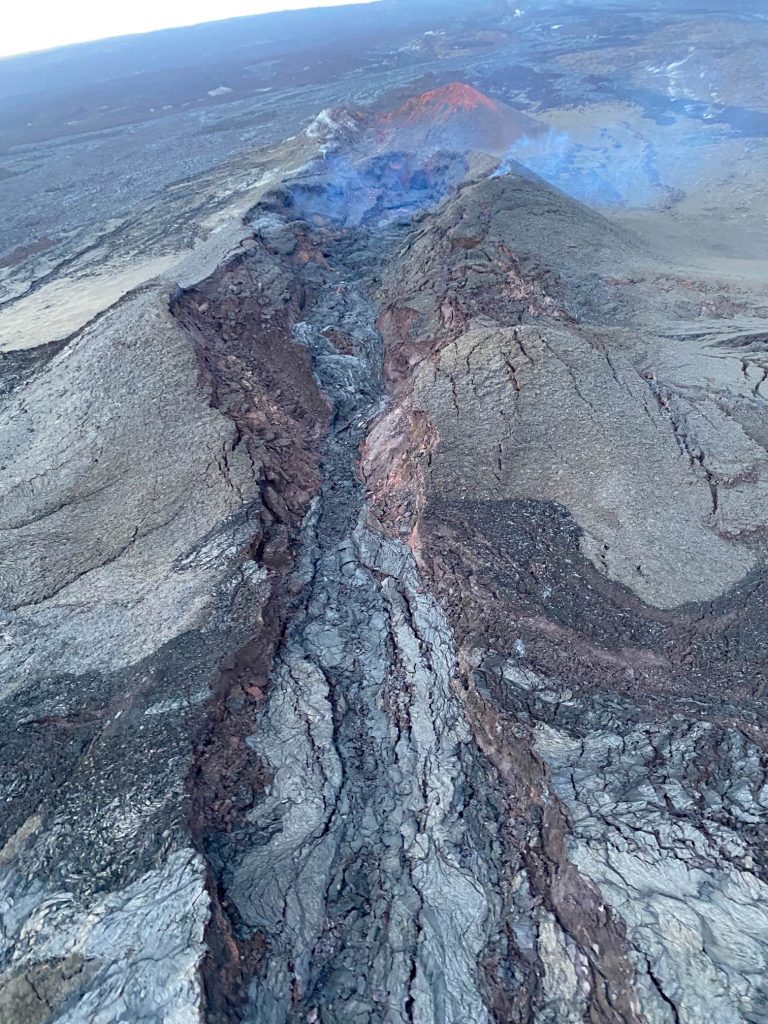HVO: Mauna Loa and Kīlauea are “no longer erupting”; volcano alert levels reduced

Mauna Loa eruption is paused,
Current eruption unlikely to resume
Mauna Loa and Kīlauea are no longer erupting, according to morning updates provided by the USGS Hawaiian Volcano Observatory.
Describing Mauna Loa’s activity as “paused,” HVO Scientists in Charge, Ken Hon said, “We don’t expect it to resume based on historical analogs for other rift eruptions of Mauna Loa. None of them have ever paused during the eruption. Certainly the high effusion rate part of that eruption is definitely over with.”
HVO scientists say the lava supply to the Fissue 3 vent at Mauna Loa ceased on Saturday, and earthquakes associated with the eruption have greatly diminished.
“Spots of incandescence may remain near the vent, along channels, and at the flow front for days or weeks as the lava flows cool. However, eruptive activity is not expected to return based on past eruptive behavior,” the HVO reports.
“This was by far the longest period of repose where the volcano was not erupting–38 years–of any historic Mauna Loa eruption,” said Hon during a morning briefing. “It’s interesting to see that the length and amount of material erupted is in keeping with prior past historic eruptions.”
The agency continues to monitor Mauna Low for signs of renewed activity, noting that inflation continues in the Summit and Northeast Rift Zone.
“There is just a small chance that there could be a resumption, but we don’t think that is likely based on the fact that the seismicity of the summit has gone down, and the tremor has gone way down–suggesting that there’s nothing really in the pipeline coming down that could cause that eruption to renew,” said Hon.
Kīlauea also stops erupting
Scientists to study impact of volcanoes on one another
Hon said scientists are keeping tabs on both Mauna Loa and Kīlauea. “Mauna Loa–we don’t really know what’s in store for us here–if we’re going back to when it might be more active like it was in the 1800s to 1950. And for Kīlauea, it still has some interesting seismicity and deformation going on, suggesting that things aren’t really over there, but they are definitely in a long term pause, not a short term pause,” said Hon.
At Kīlauea, lava supply to the Halemaʻumaʻu lava lake ceased on Friday, Dec. 9. HVO scientists made the determination based upon lava lake levels and behavior of the crater floor.
Because of the reduced activity at both locations, the USGS lowered the Volcano Alert Level for ground-based hazards from Watch to Advisory, and the Aviation Color Code was downgraded from Orange to Yellow at both volcanoes this morning.
“We believe that Kīlauea quit erupting–it’s a little hard to tell on the surface of the lake, but–sometime between Dec. 6-9. The surface of the lake has been cooling steadily. The entire Halemaʻumaʻu Crater floor, which sits on this bigger pool of lava that is still the crater, has only gone down now. That is an indicator that there is no longer lava coming in there. It’s cooling and losing gas, and contracting a little bit,” said Hon.
At Kīlauea, HVO scientists say seismicity and deformation patterns remain unsettled. The HVO reports that the potential remains for resumption of an eruption or initiation of a new eruption at or near the summit of Kīlauea.
“We do know that Kīlauea has moved back towards Mauna Loa, and extended. Some pressure has been relieved on it, and that’s one possible idea; but we’ve also been noticing that since early in November, our seismologists have been tracking a trend to see that the tremor going into Kīlauea’s eruption has been steadily decreasing. So it looks like whatever the activity before Mauna Loa erupted, Kīlauea was diminishing on its own–and that fits with (what) we know that the last time we were able to get good enough measurements to get an effusion rate, it was down from about 3-5 cubic meters / second, down to about 1 cubic meter a second,” said Hon.
“So Kīlauea may have been diminishing already, and the Mauna Loa eruption may have caused enough physical changes to stop it, or it may have just been headed to stop on its own,” said Hon, noting that scientists will continue to study any possible relation between the waning activity at the two sites over the next year or so as they comb through additional data.
DLNR re-opens some previously closed areas at Mauna Loa
The DLNR Division of Forestry and Wildlife also announced it is re-opening several areas that were closed as a result of the eruptive activity two weeks ago. The reopened areas include:
- Kapāpala Forest Reserve
- ʻĀinapō Trail, road, and cabin
- Kīpuka ʻĀinahou Nēnē Sanctuary
DLNR reports that Kapāpala Unit J re-opened for game bird hunting last Saturday. As of Monday, the Mauna Loa Forest Reserve and the Mauna Loa Observatory Road remained closed due to continued volcanic hazards. A gate is being constructed at the Mauna Loa Forest Reserve boundary on the access road and will be locked until further notice.
Note: A news briefing is scheduled for 9 a.m. This story will be updated with new information as it becomes available.
Resources and links:
- The Hawaiʻi County Civil Defense agency has a web page on volcano hazards with maps of inundation zones and hazard zones. Alerts are posted here.
- Hawai‘i Volcanoes National Park has closed the Mauna Loa summit area to visitors.
- Vog information can be found here.
- What does a warning and warning alert level mean? Find out here.
- HVO: Preparing for the next eruption of Earth’s largest active volcano.
- Lava Flows from Mauna Loa (1843-2018)
- Mauna Loa Eruption Response Times over the past 200 years
- Current alerts.
- Mauna Loa webcams.
- Frequently Asked Questions about Mauna Loa Volcano










